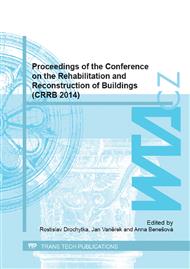[1]
Sobolkina, A., Mechtcherine, V., Bellmann, C., Khavrus, V., Oswald, S., Hampel S., Leonhardt A. Surface properties of CNTs and their interaction with silica / Journal of Colloid and Interface Science. № 413. 2014. pp.43-53.
DOI: 10.1016/j.jcis.2013.09.033
Google Scholar
[2]
Oscar Mendoza, German Sierra, Jorge I. Tobуn. Influence of super plasticizer and Ca(OH)2 on the stability of functionalized multi-walled carbon nanotubes dispersions for cement composites applications. Construction and Building Materials Vol. 47, 2013, p.771.
DOI: 10.1016/j.conbuildmat.2013.05.100
Google Scholar
[3]
E.G. Rakov. Carbon nanotubes in new materials. Uspekhi khimii, 82 (1), 2013. – P. 27-47.
Google Scholar
[4]
Rafat Siddique, Ankur Mehta. Effect of carbon nanotubes on properties of cement mortars. Construction and Building Materials 50 (2014) 116–129.
DOI: 10.1016/j.conbuildmat.2013.09.019
Google Scholar
[5]
Grigory Yakovlev, Grigory Pervushin, Irina Maeva, Jadvyga Keriene, Igor Pudov, Arina Shaybadullina, Alexander Buryanov, Alexander Korzhenko, Sergey Senkov. Modification of Construction Materials with Multi-Walled Carbon Nanotubes. 11th International Conference on Modern Building Materials, Structures and Techniques, MBMST 2013 / Procedia Engineering 57 ( 2013 ) 407 – 413.
DOI: 10.1016/j.proeng.2013.04.053
Google Scholar
[6]
A.S. Brykov, R.T. Kamaliev, M.V. Mokeev. Influence of ultrafine silica on hydration of Portland cement / Journal of Applied Chemistry. 2010. V. 83. № 2. P. 211-216.
DOI: 10.1134/s1070427210020059
Google Scholar
[7]
Singh L.P., Karade S.R., Bhattacharyya S.K., Yousuf M.M., Ahalawat S. Beneficial role of nanosilica in cement based materials / A review Construction and Building Materials. 2013. № 47. p.1069–1077.
DOI: 10.1016/j.conbuildmat.2013.05.052
Google Scholar
[8]
G. Quercia, A. Lazaro, J.W. Geus, H.J.H. Brouwers. Characterization of morphology and texture of several amorphous nano-silica particles used in concrete / Cement & Concrete Composites. 2013. № 44. p.77–92.
DOI: 10.1016/j.cemconcomp.2013.05.006
Google Scholar
[9]
AL-Salami A.E., Morsy M.S., Taha S., Shoukry H. Physico-mechanical characteristics of blended white cement pastes containing thermally activated ultrafine nano clays. Construction and Building Materials Vol. 47, 2013, p.138–145.
DOI: 10.1016/j.conbuildmat.2013.05.011
Google Scholar
[10]
Raul Arellano-Aguilar, Oswaldo Burciaga-Diaz, Alexander Gorokhovsky, Jose Ivan Escalante-Garcia. Geopolymer mortars based on a low grade metakaolin: Effects of the chemical composition, temperature and aggregate: binder ratio. Construction and Building Materials 50 (2014).
DOI: 10.1016/j.conbuildmat.2013.10.023
Google Scholar
[11]
Mechti W., Mnif T., Chaabouni M., Rouis J. Formulation of blended cement by the combination of two pozzolans: calcined clay and finely ground sand. Construction and Building Materials. Vol. 50, 2014, p.609–616.
DOI: 10.1016/j.conbuildmat.2013.10.021
Google Scholar
[12]
Patent № 2 969 143. C 04 B 16/12 (2012. 01), C 04 B 28/00. Procede D'introduction de nanocharges carbonees dans un inorganique durcissable/ Korzhenko A., Havel M., Gaillard P., Yakovlev G.I., Pervuchin G.N., Oreshkin D.V. pub. 22. 06. 12. Bulletin 12/25.
Google Scholar
[13]
G.D. Fyodorova, O.I. Matveeva, E.P. Nikolaev. On applying high-strength concretes in monolithic construction in the North. / Industrial and civil construction. 2013. № 8. P. 30-32.
Google Scholar
[14]
Methodological instructions «Infrared technique and its possibilities for studying construction materials». – Novosibirsk, NGASU, INC SO RAN, 2002. – 16 p.
Google Scholar
[15]
V.S. Gorshkov, V.V. Timashev, V.G. Savelyev. Methods of physical and chemical analysis of binding agents. Moscow, Vysshaya Shkola, 1981. – 335 p.
Google Scholar


